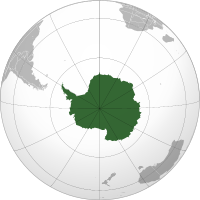
Photo from wikipedia
Antarctica, an area that is devoted to global peace and research, is being challenged by climate change, human activities, and pollution. There have been a number of studies concerning the… Click to show full abstract
Antarctica, an area that is devoted to global peace and research, is being challenged by climate change, human activities, and pollution. There have been a number of studies concerning the state of the Antarctic ecological environment. However, a comprehensive and quantitative assessment of the impact of threats on the Antarctica ecological environment is still lacking. In this study, a cumulative impact assessment performed on the basis of expert judgement was used to estimate species-specific differences on the impact of seven threats: climate change, organic and nonorganic pollutants, station construction, power generation, oil spilling, and tourism. The terrestrial area of the Fildes Peninsula was divided into 103 cells using a raster grid of 0.25 km2, and cumulative impact assessment was applied to each cell. The analysis results indicated that cumulative impact scores (IC) ranged from 0 to 39.4, and the cumulative scores were divided into six categories ranging from very low impact (IC ≤ 7.08) to very high impact (IC > 20.54). More than half of the terrestrial area (57.3%) experienced "Very Low Impact" or "Low impact" scores. For single factors, climate change was identified as a rapidly growing and significant threat facing the terrestrial ecosystems of Antarctica. In addition, tourism had the greatest impact among all human activities. The analytical process and resulting map indicate that it is necessary to develop international policies on the restriction of tourist activity space and strength the organic pollutant controls for terrestrial ecosystem protection in the Fildes Peninsula, Antarctica.
Journal Title: Journal of environmental management
Year Published: 2020
Link to full text (if available)
Share on Social Media: Sign Up to like & get
recommendations!